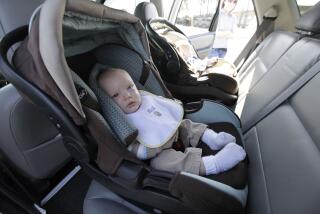The stroller habit
- Share via
Strollers are a staple in every parent’s collection of baby items, and moms and dads swear to their convenience. But they might want to consider parking those strollers.
Some pediatricians believe that the devices may be contributing to less active lifestyles for toddlers and, as a result, an increase in obesity. “Parents will walk the dog and put the child in the stroller for convenience sake,” says Dr. Joel Steinberg, professor of pediatrics at University of Texas Southwestern Medical Center at Dallas.
Steinberg acknowledges strollers are useful for keeping kids safe in crowded malls or on busy sidewalks, but cautions against strapping kids in when they could be walking. “People think that toddlers have limited ability, and it’s not true,” he says. Too much time in the stroller “teaches them that the best way to go is to ride, not to walk.”
Obesity rates, which have been climbing for children and adults, also seem to be creeping up for the under-4 set. Although the Centers for Disease Control and Prevention and other groups have only tracked children’s weights starting at age 5 or 6, many pediatricians say they’ve seen a marked increase in overweight and obese preschoolers in the last several years. Because children don’t become obese overnight, poor examples learned at an early age can have serious consequences.
As medical director of KidShape Foundation, a Los Angeles nonprofit family-focused, weight-management program for children, Dr. Naomi Neufeld is not surprised to see 2-year-olds weighing 50 pounds and 3-year-olds weighing 70 pounds (average 2-year-olds weigh 26 pounds to 29 pounds, average 3-year-olds weigh 30 to 34 pounds). “Morbid obesity in 3-year-olds is not that uncommon anymore,” says Neufeld, also a clinical professor of pediatrics at UCLA.
She says that keeping kids in strollers for long periods without allowing them time to walk is part of a larger problem in which time-crunched parents pay little attention to their children’s exercise and nutrition needs.
“This generation of parents,” she says, “is more likely to be overworked, commuting 90 miles to their job, and when they’re with their kids they’re so strapped for time and distracted that maybe they pop the kid in the stroller.”
Jane Clark, chairwoman of the department of kinesiology at the University of Maryland, says reliance on strollers is part of a larger trend in which children are “containerized.”
“It’s spending time in baby chairs rather than putting them down on the floor, or at least in playpens, which allows them more freedom,” she says. “Anything that keeps children from doing large muscle activity is going to contribute to a lack of physical activity.”
Even the design of strollers may be adding to their increased use, Clark adds. Those old heavy, cumbersome prams couldn’t be yanked out of a car with one hand the way today’s models can.
If parents aren’t thinking about excessive stroller time, it might be because they believe their always-on-the-move toddler is getting enough exercise during the day. Not necessarily true, say some experts.
“Kids who spend a lot of time in day care don’t always get that much physical activity,” says Clark. “Sometimes there’s no physical activity area, and it makes it difficult to get the kind of exercise we did when we were kids and just went out to play.”
Television as baby sitter is another culprit that can suck up time spent being active. “If parents are busy they might pop in a Barney tape, but if you’re playing them hour after hour, kids aren’t getting a lot of activity,” says Dr. Douglas Gregory, a Tidewater, Va-based pediatrician and fellow with the American Academy of Pediatrics. Sedentary parents tend to have sedentary children, and unhealthy routines could set kids up for bad habits that are difficult to break.
Steinberg says he notices more older children being pushed around in strollers -- kids as old as 5 (most children are weaned off strollers between 3 and 4).
Safety and convenience are the main reasons 38-year-old Marina Pelaez of Beverly Hills favors strollers. Her five children, ranging in age from 2 to 13, all have had their turn in one or more of Pelaez’s collection of 13 strollers.
“I only have two hands, and the stroller keeps the kids strapped in so they don’t run off,” she says. Her children don’t ride all the time -- Pelaez explains that they’ll often walk until they tire. “But,” she adds, “if they let go of your hand, at this age they’ll run right into the street. They’re so much safer in the stroller.”
Parents who tremble at the idea of being caught stroller-less should take comfort in Mila Allinson’s recent trip to the Aquarium of the Pacific in Long Beach with son Aidan, 20 months. The 36-year-old mother from Alisa Viejo arrived to discover she had forgotten to load the carriage into her SUV and “felt my life had been turned upside down for lack of a stroller.” But all was not lost.
“We ended up having a great time and, to be honest, I never missed it,” she says. “He was happier. He ran around and he was more active.”
Now, she says, “I’m not scared to leave the stroller at home anymore.”




